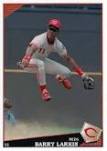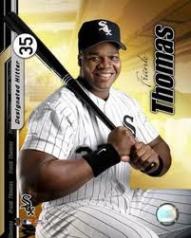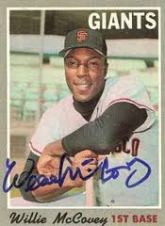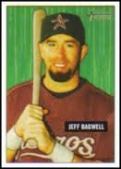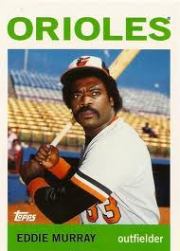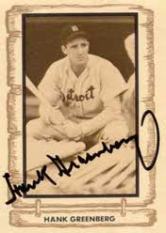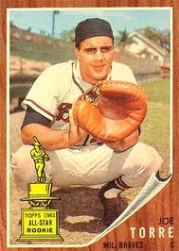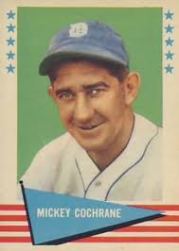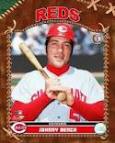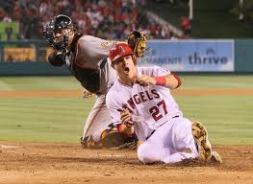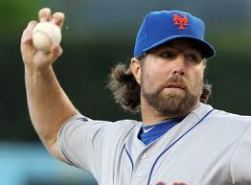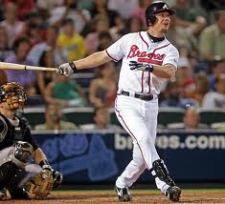Category: Uncategorized
Dan Brouthers: Forgotten Hero
The other day when I was doing some research I came across some information on Hall of Famer Dan Brouthers who played from 1878 until 1904. I’ve always known that Brouthers grew up in the Hudson Valley near where I am from but I never knew too much about him. While reading about the great Baltimore Orioles teams of the 1890s I learned that Dan Brouthers is buried in St. Mary’s Cemetery in the village of Wappingers Falls. Knowing I was going to be near there this past Sunday, my wife and I decided to go and see if we could find his grave.
Located right in the middle of Wappingers Falls, off of Main Street (Route 9D), St. Mary’s Cemetery is located behind St. Mary’s Church. The cemetery dates back to the 1850s and is still active today. Civil War, World War I and World War II vets are buried near people who have passed recently. It really is a fascinating place to visit, the history and beauty of the gravestones is incredible.
After searching for about 15 minutes, we were able to track down the grave of Brouthers and his wife, Mary Ellen. It is a very modest grave (shown) and it gives no indication of Dan’s baseball accomplishments or even his date of birth or death. If you were not a student of baseball history and knew what you were looking for, you would pass by this grave and not give it a single thought. Lost among history, Dan Brouthers is forgotten about.
Wanting to know more about Brouthers and his Hall of Fame career, I immediatley began researching him and was suprised to find that there is not much information out there. With the exception of his Wikipedia and Baseball Reference pages, there is nothing dedicated specifically to his life and career.
Dan Brouthers was born in Sylvan Lake, NY (near Hopewell Junction, NY) on May 8,1858. Brouthers began his career in 1879 with the Troy Trojans (who later became the New York Giants) and he would later play for the Buffalo Bisons, Detroit Wolverines, Boston Beaneaters, Boston Reds (Players League and American Association), Brooklyn Grooms, Baltimore Orioles, Louisville Colonels, Philadelphia Phillies and New York Giants. Known as ‘Big Dan’, Brouthers was one of the first great power hitters of professional baseball. While his 106 career home runs is not impressive by today’s standards, Brouthers played exclusively in the Dead Ball Era and his total ranks 4th all time for the 19th century.
Brouthers, who retired in 1904 after making a brief comeback with the New York Giants, had a .342 lifetime batting average / 106 HR / 1,296 RBIs / 2,296 hits / .519 SLG / .423 OBP and was elected to the Baseball Hall of Fame in 1945 by the Veterans Committee. With the exception of his batting average (9th all-time) and on base percentage (13th all-time), his numbers pale in comparison to modern players but for his day these numbers were legendary and he is often referred to as the ‘Babe Ruth of his era’.
Sadly, as time goes by, ballplayers from this era are talked about less and less and they fade into history. They become ghosts who played a less developed game. This is the way the world works and it is common throughout history that the stars or heroes from well over a century ago are overtaken by the next generation. Lou Gehrig and Babe Ruth by Ted Williams and Joe DiMaggio, Williams and DiMaggio by Mickey Mantle and Willie Mays, Mike Schmidt and George Brett by Barry Bonds and Ken Griffey, Jr., Bonds and Griffey, Jr. by Albert Pujols and Alex Rodriguez. Baseball evolves and the new replaces the old. It is sad that the start of a new generation, the older generation is forgotten about and such is the case with Dan Brouthers.
I am going to continue researching Brouthers in hopes that I am able to learn more about his life and career, hopefully I will be able to shed some light on him.
Barry Larkin and the Baseball Hall of Fame
Yesterday we talked about Ron Santo and his overdue election to the Baseball Hall of Fame. In an effort to be fair, I wanted to discuss Barry Larkin who is also being inducted this weekend in Cooperstown as well.
During his 19 year career, all with the Cincinnati Reds, Larkin hit .295 / 198 HR / 960 RBIs / 2,340 hits / 12 All-Star Game selections / 1995 NL MVP / 3 Gold Gloves.
Solid numbers, but are they Hall of Fame numbers? On paper, these numbers seem a little lower than what you would expect from a Hall of Famer. Also, Larkin scores a 0 on the Black Ink test – meaning he never led the league in any statistical category. The only way we are going to determine if he is Hall of Fame worthy is to compare him to someone who is in the Hall of Fame who played the same position. Unfortunately, the contemporary Hall of Fame shortstops who played against Larkin are some of the best shortstops of all time. It would be unfair to Larkin to compare him to Cal Ripkin, Jr., Ozzie Smith or Robin Yount. Ripkin is in a league by himself, Ozzie is arguably the greatest defensive shortstop of all time and Robin Yount was a completely different player who played half of his career in centerfield. The only Hall of Fame shortstop you could compare Larkin to would be Pee Wee Reese of the Brooklyn/Los Angeles Dodgers.
During his 16 years, Reese hit .269 / 126 home runs / 885 RBIs / 2,170 hits / 10 All-Star Game selections. Side-by-side, Larkin’s numbers are better in each offensive category, he was selected to two more All-Star games and he won an MVP while Reese never won one. However, as with any player during Reese’s generation, the three years that Reese was out of baseball while serving his country in World War II contributed to the lower numbers. From a defensive perspective, Larkin had a .975 FLD% while Reese had a .962 FLD%. Both players won one World Series Championship (Reese in 1955 and Larkin in 1990.
If you add up all of the evidence, Larkin is clearly a Hall of Fame. He is not the power hitting shortstop like Ernie Banks or Cal Ripkin, he is a throwback to a different generation where shortstops were defensive specialists who had a solid bat – they were complementary players, not the run producers like you see today. Luckily, Larkin’s lack of home runs and RBIs are not held against him and he was voted in for the player he was and not kept out because of the player he wasn’t.
Welcome to Cooperstown Barry!
Ron Santo and his overdue election into the Baseball Hall of Fame
On Friday, the baseball world will descend to Cooperstown in upstate New York for the Hall of Fame induction of Barry Larkin and Ron Santo. The small village will become the mecca of baseball with everything culminating on Sunday when all of the returning Hall of Famers return to the dais and help welcome Larkin and Santo to their exclusive club. Sadly, only Larkin will be there to enjoy the honor. Ron Santo passed away in December 2010 from bladder cancer and diabetes. He was 70 years old.
Ron Santo was clearly a great baseball player, a true Chicago Cubs legend who spent more than 30 years with the franchise both on the field and broadcasting games for WGN. The question that begs to be asked is why it took Santo thirty-three years to finally be elected to the Baseball Hall of Fame. In theory, if you are a Hall of Famer then you were a Hall of Famer the day you became eligible five years after you retired. Santo retired in 1974 with a lifetime .277 average, 342 home runs and 1,331 RBIs. He was elected to nine All-Star Games and he won five Gold Glove awards. He has not played a single game since he became eligible for induction in 1980.
Currently, I am reading Bill James’ “Whatever Happened to the Hall of Fame” which discusses who should be and who should not be in the Hall of Fame, how players are elected and what metrics are used in determining if a player is worthy of election. If you are interested in these types of discussions, definitely take a look at it. While I am not qualified to break down stats like Bill James, I wanted to incorporate some of his factors into determining whether Santo belongs in the Hall of Fame.
The first factor is referred to as ‘The Black Ink Test’ by James. Basically, did Santo lead the league in any statistical categories. The answer is yes, 12 Santo led the league in games played (162 in 1963 and 164 in 1965), triples (13 in 1964), base on balls (86 in 1964, 95 in 1966, 96 in 1967 and 96 in 1968), on base percentage (.398 in 1964 and .412 in 1966), and sacrifice flies (11 in 1963, 12 in 1967 and 14 in 1969). While he never led the league in batting average, home runs or runs batted in, these stats show Santo’s ability to stay healthy and get on base.
The second metric we will use is comparison. In order to determine if Santo belongs in the Hall of Fame we need to find a Hall of Famer who played the same position in the same era with similar statistics.
The only clear match is Brooks Robinson from an offensive perspective. Robinson scores an 11 on the black ink test. Granted, Robinson did lead the American League in RBIs once (118 in 1964), all of his other league leading categories were games played (5 times), at bats (once) and sacrifice flies (4 times) – VERY similar to Santo.
While Brooks Robinson is considered one of the greatest defensive third basemen of all time, Santo was no slouch either. While Robinson’s .971 FLD% is much better than Santo’s .954 FLD%, Santo still won five Gold Glove awards in five consecutive years. Santo also led the National League in double plays six times and total chances eight times.
Is Santo the no-doubt Hall of Famer like Brooks Robinson is? No, but he is clearly a Hall of Famer and should be been elected years ago.
In my opinion, the BBWAA should only be allowed to vote on players for 10 years instead of the current 15 years. If the BBWAA is unable to elect someone in a 10 year span, giving them another 5 years is not going to accomplish anything. I believe that the Veterans Committee should hold more power in the election process since many of the people on the committee played with and against the people they are trying to elect.
Congratulations Ron, you finally made it!
Top 10 Greatest First Basemen of All-Time
Next in the series, here is my top 10 first basemen of all time. There are a lot of great players to choose from so feel free to let me know if you think I omitted someone.
10. Frank Thomas (CWS, TOR, OAK) – .301 / 521 HR / 1667 RBIs / 2 MVPs / 5 All-Star Games
Nicknamed ‘The Big Hurt’, Frank Thomas was just that, hitting 521 home run and driving in 1667 runs during his career. From 1991 until 1997, Thomas hit at least .300 with 20 home runs, 100 runs batted in and had on base percentage higher than .400 While he was not known as a great defensive first basemen – he was eventually shifted to DH – he did have a lifetime .991 fielding percentage. Thomas is one of only three first basemen all-time to win consecutive MVP awards (1993, 1994) joined by Jimmy Foxx and Albert Pujols. While he is not eligible for induction into the Hall of Fame until 2014, Thomas had his # 35 retired by the Chicago White Sox in 2010.
9. Willie McCovey (SFG, SDP, OAK) .270 / 521 HR / 1555 RBIs / ROY / 1 MVP / 6 All-Star Games/ HOF, 1986
Once referred to as “the scariest hitter in baseball” by fellow Hall of Famer Bob Gibson, Willie McCovey comes in at #9 on our list. One of the premiere home run hitters of the 1960s, when he retired in 1980 McCovey was 9th on the all-time list (currently 18th). McCovey won the 1969 National League MVP award when he hit .320 with 45 home runs and 126 RBIs. Not known for his defense, McCovey finished with a career fielding percentage of .987. McCovey was inducted into the Baseball Hall of Fame in 1986, his first year of eligibility.
8. Jeff Bagwell (HOU) .297 / 449 HR / 1529 RBIs / ROY / 1 MVP / 4 All-Star Games / 1 Gold Glove
One of the ‘Killer B’s”, Jeff Bagwell comes in at #8 on our list. One of the greatest all-around first basemen of the early 1990s and early 2000s, Jeff Bagwell slugged 469 home runs and drove in 1528 RBIs in his 15-year career which was plagued by an arthritic shoulder. Teaming with Craig Biggio, Derek Bell and later on – Lance Berkman, Bagwell helped form the “Killer B’s” which helped lead the Astros to the playoffs in 1997-1999, 2001 and the 2005. During the strike shortened 1994 season, Bagwell was named the National League MVP when he hit .368 with 39 home runs and 116 RBIs. Eligible for induction into the Baseball Hall of Fame since 2010, Bagwell had his # 5 retired by the Astros in 2007.
7. George Sisler (SLB, WSH, BSN) .340 / 102 HR / 1175 RBIs / 1 MVP / HOF, 1939
‘Gentleman George’ comes in at #7 on our list of greatest all-time first basemen. Playing for the lowly St. Louis Browns, Sisler was considered to be one of the greatest players of his era. A lifetime .340 hitter who hit over .400 twice in his career, Sisler set the Major League record for hits in a season with 257 (in a 154 game season) which has since been broken by Ichiro Suzuki (in a 162 game season). During his 15-year career, Sisler had 200 or more hits, 6 times and was named the 1922 American League MVP when he hit a career high .420. That same year, Sisler set a Major League record with a 41-game hitting streak which stood until Joe DiMaggio’s record 56 game hitting streak in 1941. Sister was inducted into the Baseball Hall of Fame in 1939.
6. Harmon Killebrew (WSH, MIN, KCR) .256 / 573 HR / 1584 / 1 MVP / 11 All-Star Games / HOF, 1984
‘Killer’ comes in at #6 on our list. One of the biggest icons of the Minnesota Twins franchise, Harmon Kilebrew hit 573 home runs which was 6th on the all-time list when he retired in 1971. Prior to Alex Rodriguez, Killebrew set the record for most home runs by a right-handed hitter in American League history. Known for tape-measure shot home runs, Killebrew set the record for farthest home run hit in Minnesota’s Metropolitan Stadium at 520 feet. Killebrew led the American league in home runs (six times), RBIs (three times), slugging percentage (once), base on balls (four times) and on base percentage (once) during his 22-year career. Harmon Killebrew was inducted into the Baseball Hall of Fame in 1984.
5. Eddie Murray (BAL,LAD,NYM,CLE,ANA) .287 / 504 HR / 1917 RBIs/ ROY / 8 All-Star Games / HOF, 2003
Eddie Murray comes in at #5 on our list. Murray, one of the most durable and consistent hitters in history, is one of only four people in history have 3,000 hits and 500 home runs (Hank Aaron, Willie Mays & Rafael Palmeiro). Playing the majority of career with the Baltimore Orioles, Murray was the 1977 Rookie of the Year and was selected to eight All-Star Games. One of the most prolific switch hitters in history, Murray is second to only Mickey Mantle in home runs by a switch hitter (504)and has the record for most RBIs by a switch hitter (1917). Murray was inducted into the Baseball Hall of Fame in 2003.
4. Hank Greenberg (DET, PIT) .313 / 331 HR / 1276 RBIs / 2 MVPs / 4 All-Star Games/ HOF, 1956
Hammerin’ Hank Greenberg comes in at #4 on our all-time list. On paper, Greenberg’s stats are not nearly as impressive as some other players on our list but unlike the others, Greenberg did not play baseball for three years while he served in the Army during World War II. Because of this, Greenberg only played 13 seasons. During those 13 seasons, Greenberg averaged 38 home runs and 148 RBI’s. A two-time American League MVP, Greenberg’s 58 home runs in 1938 were the most hit in baseball between Babe Ruth’s 60 in 1927 and Roger Maris’ 61 in 1961. Greenberg retired when he was only 36 years old in 1947 and was inducted into the Baseball Hall of Fame in 1956.
3. Albert Pujols (STL, ANA) .325 / 460 HR / 1382 RBIs / ROY / 3 MVPs / 9 All-Star Games
Albert Pujols comes in at #3 and is the only active Major Leaguer on our list. Pujols is the only player in history to hit at least 30 home runs, drive in 100 runs and hit over .300 in each of his first 10 seasons. A three-time National League MVP, Pujols led the St. Louis Cardinals to World Series Championships in 2006 and 2011. Known as perhaps the best hitter in baseball and one of the best of all time, Pujols is also a solid defensive first basemen, having won two Gold Glove Awards. Assuming he stays healthy, Pujols is a lock to join the Hall of Fame after he retires.
2. Jimmy Foxx (PHA, BOS, CHC, PHI) .325 / 534 HR / 1922 RBIs / 3 MVPs / 9 All-Star Games / HOF, 1951
‘Double X’ is our second greatest first baseman of all-time. Splitting his career primarily between the Philadelphia Athletics and the Boston Red Sox, Foxx was the youngest player to reach 500 career home runs which was surpassed by Alex Rodriguez in 2007. Finishing his career with 534 home runs, Foxx was second only to Babe Ruth on the all-time home runs list when he retired. Known as one of the greatest run producers in history, Foxx is still 9th all time with 1,922 RBIs. Foxx was also one of the best defensive first baseman of his day, finishing his career with a .992 fielding percentage. Foxx retired after the 1945 season and was inducted into the Baseball Hall of Fame in 1951.
1. Lou Gehrig (NYY) .340 / 493 HR / 1995 RBIs / 2 MVPs / 7 All-Star Games / HOF, 1939
‘The Iron Horse’ is our greatest first baseman of all time. Playing his entire career teamed with Babe Ruth and the Murderers Row Yankees, Lou Gehrig was one of the greatest power hitters and run producers in history. Hitting clean-up behind Babe Ruth, Gehrig would go on to lead the league in home runs four times and RBIs five times. Gehrig set the American League for runs batted in 1931 with 184, only 7 fewer than Hack Wilson’s Major League record of 191. Unfortunately, Gehrig was forced to retire from baseball in 1939 when he was only 36 years because he became sick with what was later called ALS or ‘Lou Gehrig’s Disease’. Gehrig passed away in 1941 but was elected to the Hall of Fame in in 1939 after the 5-year waiting period after retirement was rescinded.
There you have it, the top 10 first basemen of all-time. Feel free to share your thoughts and let me know if you feel someone else should have been selected. Next up, the second basemen!
Top 10 Greatest Catchers of All-Time
Here is my first article on on the all-time greatest players at each position, today we will talk about catchers. This is all based on my personal opinion so please, feel free to tell me why I’m wrong.
10. Joe Torre (MLN, ATL, STL, NYM) .297 / 252HR / 1185RBIs / 9 ASGs / 1 MVP
People usually think of Joe Torre as the manager of the New York Yankees who won four World Series Championships and six American League Pennats from 1996 until 2007. However, it is easy to forget that Torre was considered one of the best catchers of his era and had a borderline Hall of Fame career. Torre had a .990 field percentage and threw out 41% of runners attempting to steal. While he spent almost equal time at first base and third base in his career, Torre comes in at #10 on my list because his combination of power and defense stand out.
9. Mike Piazza (LAD, FLA, NYM, SDP, OAK) – .308 / 427 HR / 1335 RBIs / 12 All-Star Games, 1 ROY
Mike Piazza is arguably the greatest offensive catcher of all-time. Normally, this would put you higher up on the list but Piazza was awful offensively. Known as a liability behind the plate, Piazza did have a respectable .989 fielding percentage but he threw out an anemic 23% of base runners. Piazza hit what might be the most famous homerun of the last 20 years on September 21, 2011. On a somber night at Shea in the first game back after resuming the season following the September 11th terrorist attacks, Piazza’s two-run homerun clinched the win for the Mets and lifted up the spirits of a heartbroken city.
8. Bill Dickey (NYY) – .313 / 202 HR / 1209 RBIs / 11 All-Star Games / HOF, 1954
Until Yogi Berra came along, Bill Dickey was the standard for catchers – not only for the New York Yankees but for all of Major League Baseball as well. From 1936 – 1939, Dickey hit over 20 home runs and drove in over 100 runs each year which were four of the best offensive seasons by a catcher ever at the time. With a field percentage of .988, Dickey threw out 47% of runners who attempted to steal. As a member of the Yankees, Dickey won eight World Series Championships and another 6 as a coach for an astounding total of 14. Enshrined in the Hall of Fame in 1954, Dickey’s number 8 was retire by the Yankees in 1972.
7. Gabby Hartnett (CHC, NYG) – .297 / 236 HR / 1179 RBIs / 6 All-Star Games / 1 MVP / HOF, 1955
Gabby Hartnett is remembered as being a part of some of the greatest moments in baseball history. He was the catcher for the Cubs in the 1932 World Series when Babe Ruth called his shot, he was the catcher in the 1934 All-Star Game when Carl Hubbell struck out Ruth, Gehrig, Foxx, Simmons and Cronin in order and in 1938 when he hit a game winning home run to put the Cubs into first-place during the last week of the season as the sun was setting – forever being known as the ‘Homer in the Gloamin’. But if you look at Hartnetts career, both offensively and defensively, he is one of the greatest ever. His 57% caught stealing percentage is the highest of all time and he finished with a fielding percentage of .984. Hartnett was inducted into the Hall of Fame in 1955.
6. Mickey Cochrane (PHA, DET) – .320 / 119 HR / 832 RBIs / 2 All-Star Games / 2 MVPS / HOF, 1947
Mickey Cochrane has the highest lifetime batting average and OBP (.419) of any retired catcher in baseball history and he was the first catcher to score and drive in 100 runs in the same season. While he was not the best defensive catcher – .985 fielding percentage and 39% caught stealing percentage – he is arguably one of the top 5 offensive catcher in history. Cochrane, a three time World Series Champion, was elected into the Baseball Hall of Fame in 1947.
5. Carlton Fisk (BOS, CWS) – .269 / 376 HR / 1330 RBIs / 11 All-Star Games / 1 ROY / HOF, 2000
The preeminent catcher of the late 1970s and 1980s, Carlton Fisk is number five on our list of top catchers of all-time. The picture of Fisk waiving his homerun fair in the 1975 World Series is etched into the minds of all baseball fans. When he retired, Fisk held the record for most homeruns by a catcher and most games behind the plate. While both records have since been broken, Fisk was the gold-standard for consistency and production in his era and was elected the Hall of Fame in 2000.
4. Ivan Rodriguez (TEX, FLA, DET, NYY, HOU, WSN) – .296 / 311 HR / 1332 RBIs / 14 All-Star Games / 1 MVP
Arguably the greatest defensive catcher of all time, Ivan ‘Pudge’ Rodriguez is # 4 on our list all-time greatest catchers. In 1999 Rodriguez had one of the best seasons by catcher in history, when he hit .332 with 35 homeruns, 113 RBIs and 25SBs while winning the American League MVP award. In 2009, Rodriguez surpassed Carlton Fisk for the most games behind the plate. Finishing his career with a .991 fielding percentage and a 46% caught stealing percentage, Rodriguez retired in 2012.
3. Roy Campanella (BRO) – .276 / 242 HR / 856 RBIs / 8 All-Star Games / 3 MVPs / HOF, 1969
A pioneer in Major League Baseball, Roy Campanella comes in at # 3 on the list of all-time greatest catchers. One of the first Afican American players to play in Major Leagues after Jackie Robinson broke the color barrier in 1946, Campanella quickly became one of the best backstops in history. One of the greatest hitting catchers of all time, Campanella was also an excellent defensive catcher who threw out 57% of men trying to steal. Sadly, Campanella’s career was cut short after only 10 years in 1958 when he was paralyzed in a car accident. Campanella was inducted into the Hall of Fame in 1969.
2. Yogi Berra (NYY, NYM) – .285 / 358 HR / 1430 RBIs / 18 All-Star Games / 3 MVPs / HOF, 1972
One of the most colorful characters in baseball history, Yogi Berra is our second greatest catcher of all time. Berra is the most decorated catcher in baseball history, having won 13 World Series Championships with the Yankees – a feat which will most certainly never be matched. Combining power and clutch hitting, Berra hit 358 home runs (305 as a catcher) which is 4th most in history. He is only the second catcher in history to win three MVP awards (the other being Roy Campanella) and his 18 All-Star Game selections are the 7th most in history. Berra, who had his # 8 jersey retired by the Yankees in 1972 (along with Bill Dickey), was elected to the Hall of Fame in 1972.
1. Johnny Bench (CIN) – .267 / 389 HR / 1376 RBIs / 14 All-Star Games / 2 MVPs / ROY / HOF, 1989
Cincinnati Reds legend, Johnny Bench has been selected the greatest catcher of all time. As the backbone of the 1970s ‘Big Red Machine’, Johnny Bench helped lead the Reds to the 1975 and 1976 World Series Championships. The premeinent catcher of his generation and a standard in which all catchers are judged, Bench won two MVP awards and was selected to 14 All-Star Games. When he retired Bench held the record for games caught and home runs. Bench was inducted into the Hall of Fame in 1989
Hall of Famer Spotlight: Carl Hubbell
When baseball fans think of Carl Hubbell, the first thing that comes to mind is the 1934 All-Star Game when Hubbell struck out Babe Ruth, Lou Gehrig, Jimmie Foxx, Al Simmons and Joe Cronin in succession. When you look deeper, you learn that Hubbell was one of the greatest pitchers of all time.
Born in Carthage, MO on June 22, 1903. Hubbell began is professional career when he was signed by the Detroit Tigers in 1926. Ty Cobb, who was the Tigers’ player-manager at the time, was not impressed by the young lefty and was sent to the Toronto Maple Leafs in the International League. After going 7-7 on a playoff team, Hubbell returned to spring training expecting to make the Tigers. Instead Cobb, who was still not impressed, sent Hubbell back to the minors. This time to the Decatur Commodores of the Indiana-Illinois-Iowa League. After going 14-7 he was not invited back to Tigers spring training and was sent to the Beaumont Exporters of the Texas League. Fed up with the minor leagues, Hubbell demanded to be traded by the end of the season.
While pitching for the Exporters, New York Giants scout Greg Kinsella noticed Hubbell and informed Giants legendary manager, John McGraw, that Hubbell was released by the Tigers due to Cobb’s concerns about him throwing a screwball. McGraw, who managed fellow screwball pitcher Christy Matthewson, was not concerned and signed Hubbell a month later.
During Hubbell’s 16-year tenure with the Giants, New York won three National League pennants and the 1933 World Series. During 1936 and 1937, Hubbell won 24 consecutive starts and he would win at least 20-games in five consecutive seasons (1933-1937), notch the 1933 and 1936 MVP award and be selected to nine All-Star Games.
Hubbell would retire in 1943 with a lifetime record of 253-154, 2.98 ERA, 1,677 strikeouts and was elected to the Baseball Hall of Fame in 1947 Following his playing career, Hubbell continued working with the Giants for 35 years as the director of their minor league system, Director of Player Development and scout.
Carl Hubbell passed away on November 21, 1988 after being injured in a car accident in Scottsdale, AZ.
Information gathered from Wikipedia, Baseball-Reference.com, CarlHubbell.com, National Baseball Hall of Fame.
2012 MLB First-Half Awards
The second half of the Major League Baseball season is set to begin on Saturday so I thought this would be the perfect opportunity to give out awards for the first half of the season.
American League MVP:
Choices:
1. Josh Hamilton (TEX) – .308/27HR/75RBIs/1.016OPS. Hamilton is having a monster year on a great team. After hitting .395/9HR/25RBIs in April and .344/12HR/32RBIs in May he cooled off significantly in June to .223/4HR/16RBIs but he still leads the league in home runs, RBIs, slugging percentage and OPS.
2. Mike Trout (LAA) – .341/12HR/40RBIs/26SBs. At only 20 years old, Trout is off to an amazing start to his career. A 5-tool talent, Trout has almost single-handedly resurrected the Angels season. Before being called up on April 28th, the Angels were 6-14 and in last place in the American West. With Trout in the lineup, the Angels are 42-24.
3. Robinson Cano (NYY) – .313/20HR/51RBIs/.953OPS. Through May, Cano had only hit 8 home runs and driven in 23 runs. But since June, Cano has hit .345 with 12 homers and 28 RBIs while continuing to play gold glove defense at second base.
Selection:
Mike Trout. Since he was called up on April 28th, there has not been a player more valuable to his team than Trout. He is on pace to hit almost 30HR, drive in 100 runs and steal 50 bases. The Angels will make a serious run at Texas for the AL West crown and Trout will be the one leading the charge.
American League Cy Young:
Choices:
1. Justin Verlander (DET) – 9-5/2.58ERA/128Ks. Verlander is coming off one of the most dominating seasons in history and it has carried over to this season. While his 9-5 record is more of an indication of the Tigers sub par first half, Verlander has been a workhorse. He leads the American League in strikeouts and innings pitched (132.2).
2. Jered Weaver (LAA) – 10-1/1.96ERA/0.90WHIP. Weaver is having an incredible season. With a 10-1 record, he is leading the American League in ERA, has thrown a no-hitter and has accomplished all of this while still serving two weeks on the disabled list. While his strikeout totals are down from where they normally are (73Ks in 96.2 innings), he has become more of a complete pitcher (only 65 hits allowed / almost 4:1 strikeout to walk ratio).
3. David Price (TAM) – 11-4/2.82ERA/105Ks). After a lackluster 2011 season, Price is back at the top of his game. On a team that has been hurt by injuries and a general inability to score runs, Price is leading the American League in wins, 5th in ERA and is 7th in strikeouts.
Selection:
Jered Weaver. Verlander and Price are having great season and each deserves this award but I think Weaver takes the award because he is flat out dominating. Looking at the wins and ERA only tells you so much. His 0.90 WHIP is filthy and the fact that he has given up 31 fewer hits than innings pitched wins him the award.
American League Rookie of the Year
Choices:
1. Mike Trout (LAA) – .341/12HR/40RBIs/26SBs. Like I mentioned in the MVP discussion, Trout is having a phenomenal rookie season. With Pujols having a below normal first season in the American League, Trout has picked up the slack and ignited the team.
2. Yu Darvish (TEX) – 10-5/3.59/117Ks. With all the hype that surrounded the Darvish signing, I wasn’t really sure what to expect. As it turns out, Darvish has flourished in the American League West and has helped lead the Texas staff which was hurt by the loss of CJ Wilson to the Angels.
3. Jarrod Parker (OAK) – 5-4/2.86ERA/6.9H/9. The final selection came down to either Jarrod Parker or Matt Moore from Tampa Bay. Ultimately, Parker won out because his ERA is 1.5 runs per game less than Moore. Also, Oakland is not nearly as good as Oakland so for Parker to have an above .500 record with a 2.86 ERA is impressive.
Selection:
Mike Trout. Easy decision. Darvish comes in second and Parker is a distant third. Trout could become the first rookie to win the MVP and ROY since Fred Lynn in 1975.
National League MVP:
Choices:
1. Andrew McCutchen (PIT) – .362/18HR/60RBI/.625SLG. People have always said that McCutchen was raw a talent and that he would need time to mature as a player. This year is his coming out party. McCutchen is leading the league in batting average and slugging percentage and is the main reason the Pirates are in first place and are on the cusp of making the playoffs for the first time since 1992.
2. David Wright (NYM) – .351/11HR/59RBIs/.441OBP. No one in baseball expected the Mets to do anything this year but Wright’s career year has helped propel a mostly anemic offense to second place in the NL East. If Wright’s bat can stay hot, the Mets have a legitimate shot to stay in contention deep into September and perhaps win the division or grab one of the wild card slots.
3. Joey Votto (CIN) – .348/14HR/48RBIs/.471OBP. Votto is one of the best hitters in baseball and the 2010 NL MVP. His OBP is off the charts and his power number should increase as the season goes on. He is a consisten 30HR/100 RBI guy.
Selection:
Andrew McCutchen. The last time the Pirates played in October, Bonds, Bonilla and Van Slyke were the stars. McCutchen is the face of this franchise and he is the real deal. Wright is a close second but McCutchen has more home runs and slugging percentage is higher and that gives him the edge.
National League Cy Young:
Choices:
1. R.A. Dickey (NYM) – 12-1/2.40ERA/123Ks. The season that R.A. Dickey is having is nothing short of amazing. On paper you assume he’s a Verlander-esque type pitcher, but once you realize that he is a knuckleball pitcher his stats are mind-blowing. He is having arguably the greatest season EVER by knuckleball pitcher.
2. Matt Cain (SFG) – 9-3/2.62ERA/118Ks. Finally, the stats that Cain is putting up are matching his talent. Having thrown a perfect game this year, Cain has been absolutely fantastic.
3. Gio Gonzalez (WSH) – 12-3/2.92ERA/118Ks. Considered to be a solid # 2 behing Strasburg, Gonzalez is having a season on par with the young phenom. With 17 more strikeouts than innings pitched and 30 less hits than innings pitched, Gonzalez has risen to the occasion after coming over from the Athletics in the off-season.
Selection:
R.A. Dickey. The season he is having is absolutely incredible. He is the winner in a landslide in my opinion
National League Rookie of the Year:
Choices:
1. Bryce Harper (WSH) – .282/8HR/25RBIs/10SB. With all of the hype that Harper has received since high school, it would have been understandable for him to falter in his first season in the big leagues. Instead, Harper has helped inspire the Nationals and if one of the reasons they are in first place.
2. Lance Lynn (STL) – 11-4/3.41ERA/105Ks. Lynn was St. Louis’s first-round pick in 2008 out of Ole Miss and he has been lights out this year. He has more strikeouts than innings pitched, he has given up 15 less hits than innings pitched and he is sitting at a 3:1 strikeouts to walk ratio. How he does in the second half will determine whether or not St. Louis can make it back to the playoffs.
3. Wade Miley (ARZ) – 9-5/3.04ERA/70Ks. Miley is another product of the deep 2008 draft class, having been selected in the first-round out of Loranger HS in Loranger, LA. Not an overpowering pitcher but he knows how to hit his spots and has pitched very well for a below-.500 Diamondbacks team.
Selection:
Lance Lynn. Harper is going to be the popular choice here but I believe Lynn is having the better season. Harper’s .282 batting average and 25RBI’s are unspectacular and while Lynn’s 11-4 record is impressive. Harper might end up having the better career but Lynn is having the better season.
There you have it, my 1st half award winners. We’ll see how the season plays out and if these guys can continue to produce. One thing is for sure, we are in for an exciting late spring and early Fall.
2012 All-Star Game Recap
Well, last night’s All-Star Game was a surprise. I never expected the National League to come out and just punish the American League. Justin Verlander started and was sitting between 96-101mph on the gun and getting hit hard. You could tell from the start he was amped up and he was leaving everything up. I think he relied a little too much on his fastball, if he mixed in his curve and change a little bit more I think he could have limited the damage.
It’s safe to say the San Francisco Giants stole the show. Matt Cain threw two shutout innings, Pablo Sandoval had a huge three-run triple and Melky Cabrera went 2-for-3 with two runs, two RBIs and a home run while taking home MVP honors.
Derek Jeter passed Mickey Mantle for first place on the all-time All-Star Game hits list. Congrats DJ!
Rookie phenom, Bryce Harper, had a tough game. After being hung up between second and third , Harper lost a Mike Napoli fly ball in the lights and the ball landed ten feet behind him.
Robinson Cano finally snapped his 0-for-All-Star Week drought with a 4th inning single off Stephen Strasburg.
It was good to see Chipper Jones single in his final All-Star Game at bat.
The R.A. Dickey Show finally made an appearance after all of the debates about whether or not he should have started the game instead of Matt Cain. One inning pitched, 1BB/1K. It will be interesting to see if he can continue his magic in the second half, if not the Mets are doomed.
Next year’s ASG returns to New York as Citi Field plays host. Arguably one of the most difficult places to hit a home run in Major League Baseball, the home run derby should be interesting. My money is on Prince Fielder for a third time. The most beautifully violent swing in baseball, you are going to need some serious power to light up the apple.
The regular season resumes on Friday, back to the grind. Some story lines to watch:
1. Can the Mets continue their incredible season?
2. Can Matt Kemp’s return to the lineup turnaround the slumping Dodgers?
3. Will the Phillies unload at the trade deadline?
4. How will the two wild card playoff race play out?
Should be interesting!
All-Star Game Predictions
The 2012 All-Star Game is upon us! If last night’s home run derby was any indication, tonight’s All-Star Game in Kansas City is going to be a fun one.
I just wanted to put out a quick post with my predictions, let’s see how I do:
American League 8 National League 4
MVP: Josh Hamilton
Winning Pitcher: Chris Sale
Losing Pitcher: R.A. Dickey
Chipper Jones’s place in history
By now, everyone knows that Chipper Jones is in the midst of his final season and is planning on retiring having played his entire 18-year career with the Atlanta Braves. His place in Cooperstown is secure and he will go down as one of the greatest to ever play for the Braves.
Personally, I’ve always enjoyed watching him play. Solid guy, great player, clutch hitter. He’s a throwback to a different generation. If you are a Mets fan, which I’m not, there was nothing scarier than #10 coming to the plate in the late 90s. Chipper owned the Mets. In 234 career games, he is hitting .316 with 48 homers and 156 RBIs. He even took it a step further and named his son after the Mets old stadium, Shea.
Would you consider him one of the greatest third basemen of all-time?
The answer to this is yes. Mike Schmidt, Eddie Mathews, Brooks Robinson, George Brett and Alex Rodriguez are my top 5 and Chipper would be #6. Let’s break it down a bit:
1. Mike Schmidt – .267/548HR/1595RBIs (3 MVPs, 12 All-Star Games, 9 Gold Gloves, HOF)
2. Eddie Mathews -.271/512HR/1453RBIs (9 Gold Gloves, HOF)
3. Brooks Robinson – .267/268HR/1357RBIs (1 MVP, 15 All-Star Games, 16 Gold Gloves, HOF)
4. George Brett – .305/317HR/1596RBIs (1 Rookie of the Year, 1 MVP, 13 All-Star Games, 1 Gold Glove, HOF)
5. Alex Rodriguez – .301/642HR/1931RBIs (3 MVPs, 14 All-Star Games, 0 Gold Gloves as a third basemen)
6. Chipper Jones – .304/460HR/1594RBIs (1 MVP, 8 All Star Games, 0 Gold Gloves)
Mike Schmidt is clearly the greatest third baseman of all time, the only person who rivals him offensively is Alex Rodriguez and he played ten years at shortstop with Seattle and Texas before moving to third base when he joined the Yankees.
Brooks Robinson is by far the greatest defensive third baseman of all time, 16 Gold Gloves is mind-boggling.
I give the edge to Brett over Jones, even though Chipper has 143 home runs, because Brett has 3,154 hits – almost 500 more than Chipper.
If you want to take it one step further, do you think that Jones is one of the three best switch hitters of all time? Easy question, yes. Mickey Mantle, Eddie Murray, Chipper Jones, Pete Rose. Here is the breakdown:
1. Mickey Mantle – .298/536HR/1509RBIs (3 MVPs, 16 All-Star Games, HOF)
2. Eddie Murray – .287/504HR/1917RBIs (Rookie of the Year, 0 MVPs, 8 All-Star Games, 3 Gold Gloves, HOF)
3. Chipper Jones .304/460HR/1594RBIs (1 MVP, 8 All-Star Games)
4. Pete Rose – .303/160HR/1314RBIs (Rookie of the Year, 1 MVP, 17 All-Star Games, 2 Gold Gloves)
Mantle’s power to go along with his seven World Series rings make him the greatest switch hitter of all time in my opinion but not by much. While Mantle did suffer with injuries for most of his career, the longevity of Murray (21 seasons) along with his 3,255 hits and 504 home runs make him a close second. The only person who could come close to being # 3 all time instead of Chipper is Pete Rose but I give the nod to Chipper because of the power numbers.
Only time will tell how history will treat Chipper Jones but in my opinion he is clearly one of the greatest third baseman of all time and a first ballot HOF’er. See you in Cooperstown Chipper!

